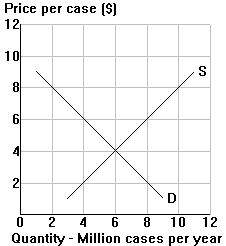Market for tutoring sessions: Market for cable TV services:


Size of shortage = ______ Size of welfare loss = ______
| Jim Whitney | Economics 101 |
Midterm: Fall 1996
| Name: ______________________________ | Exam number: ______ |
Greetings. Please write your name on the line above and write your exam number but NOT your name on the cover of your blue book AND on you supplementary worksheet. You must turn in your test copy AND your blue book AND your supplementary worksheet to receive a passing grade for the exam.
Please answer each of the exam questions as well as you can. Available exam points are distributed in proportion to the recommended time limits listed in the exam. The recommended times sum to 50 minutes, but you will be given 55 minutes to complete the exam. Do the best you can on each question, and keep in mind that plenty of partial credit is available.
Don't forget the Oxy spirit of honor. Please do NOT discuss this exam AT ALL
until 2:30 this afternoon. Good luck!
1. (6 minutes) Answer in your blue book any one of the Cooperative Learning Lab (CLL) questions which appears on the page attached to the end of this exam. (Available only at CLL.)
2. (12 minutes) Suppose the price of coffee rose sharply last month,
but the quantity sold was the same as ever. For each person quoted below,
explain whether the explanation offered could be right and use a diagram to support
your answer. Consider each person separately, and note that more than one person
could be right.
a. Person 1: "The wage rate of coffee workers rose, while the
price of coffee cake fell, and the effects canceled each other out."
b. Person 2: "Unusually good weather led to a large coffee crop,
while the economy came out of a recession (causing income to rise), and the effects
canceled each other out."
c. Person 3: "Supply shifted left, but the demand for coffee is
inelastic, with the size of the price elasticity of demand equal to 0.3."
3. (6 minutes)
a. State the benefit-cost rule for economic
decisionmaking.
b. Explain how the benefit-cost rule applies to
each of the following:
i. Whenever there is
overproduction and overconsumption in a market, there is a welfare loss associated with
each of the excess units produced and consumed.
ii. Whenever there is
underproduction and underconsumption in a market, there is a welfare loss associated with
each of the foregone units (which should be produced and consumed but aren't).
4. (12 minutes) Consider the attached article, "Gasoline Dealers Absorbing
Part of Nickel Tax."
a. Use price information approximating the
values reported in Passage A to draw a supply and demand diagram for the gasoline market
in which you show (i) an initial equilibrium (before the tax went into effect) and (ii) a
final equilibrium (after the tax went into effect).
b. Clearly label in your diagram the new price
paid by buyers (including the tax) and the new (after-tax) price received by gasoline
sellers. Is the price information you labeled in your diagram consistent with the title of
the article? Explain briefly.
c. Indicate each of the following consequences
of the tax in your diagram:
i. the change in
consumer surplus
ii. the change in
producer surplus
iii. the government tax
revenues collected
iv. the welfare loss
resulting from the tax.
d. The demand for most products, including
gasoline, tends to be more elastic in the long run than in the short run, since the long
run gives consumers more time to find substitutes. Considering that information, decide
whether each of the following is true or false, and explain briefly:
i. The revenue that
government collects from a tax on a product tends to be larger in the long run than in the
short run.
ii. The amount of
underprodution and therefore the welfare loss from a tax on a product tends to be larger
in the long run than in the short run.
5. (6 minutes) Use the diagrams on the supplementary work sheet to
answer each of the following. Put your answers directly on the work sheet.
a. In the market for tutoring sessions:
Indicate and calculate the size of the shortage which results when a price ceiling of $4
per session is implemented.
b. In the market for cable TV service: Indicate
the welfare loss which results if a monopoly provider charges a subscription price of $40
per month.
c. In the market for beer: (i) diagram the
social marginal cost curve if the production of beer results in external water pollution
costs of $4 per case produced, and then (ii) illustrate in your diagram the welfare loss
which results with the competitive equilibrium if there is no policy to encourage the
market to take the external costs into account.
6. (8 minutes) Consider the following two policies recently enacted
to help low-income workers:
i. an increase in the minimum wage to $5.10 per
hour.
ii. a wage subsidy offered to employers when
they hire low-income workers (one criterion for qualifying for the subsidy is if the job
applicant receives food stamps).
Decide whether each of the following is true or false, and carefully
explain your answer in each case (note: a diagram is not necessary for full
credit):
a. Both policies will tend to raise the wage
received by low-income workers.
b. Both policies will tend to increase the
employment of low-income workers.
Midterm: Fall 1996: Supplementary worksheet
Exam # ______
Market for tutoring
sessions:
Market for cable TV services:


Size of shortage =
______
Size of welfare loss = ______
Market for beer:
